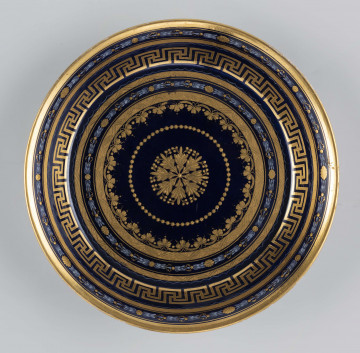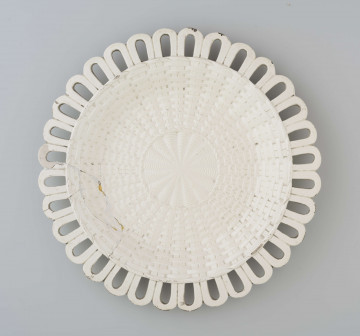
Cup
1807
National Museum in Lublin
Part of the collection: English stoneware – Wedgwood
A vase from Josiah Wedgwood's English workshop, stylised as an ancient vessel, is an example of the company's designers' use of motifs from both Greco-Roman and Egyptian mythology.
Josiah Wedgwood, who lived between 1730 and 1795, although a man from the plebs, broke the barrier of the 17th-century English social hierarchy with his diligence and talent. Initially, he was an ordinary potter, doing hundreds of experiments to perfect his craft. He became famous for his original technique of using unglazed pottery, called biscuit, for the production of which he took inspiration from the so-called Portland Vase, an ancient urn for ashes made of transparent navy blue overlaid with a relief of opaque white glass. In keeping with the spirit and taste of the Classical period, Josiah Wedgwood took from the Portland Vase both the concept of a two-colour composition with a white relief on a darker plain background and the antique theme. He became famous for the technique he developed to produce blue and white wares famous in England and throughout Europe. It is worth noting that Josiah Wedgwood is, above all, a man of great merit for the development of ceramic art. He created the jasperware type and developed research on the production of porcelain and faience, which contributed to the flourishing of English ceramics in the Staffordshire region.
The ancient Egyptian-inspired vase on display at the National Museum in Lublin, in the form of a fruit-shaped bowl on three sphinx-headed hermaphrodite legs set on a low round pedestal, is an excellent example of the Wedgwood style.
Author / creator
Dimensions
cały obiekt: height: 12 cm, width: 16,5 cm
Object type
dish
Technique
ceramic technique
Material
jasper stoneware
Creation time / dating
Creation / finding place
Owner
The National Museum in Lublin
Identification number
Location / status

1807
National Museum in Lublin

1799
National Museum in Lublin

1820 — 1830
National Museum in Lublin
DISCOVER this TOPIC
National Museum in Lublin
DISCOVER this PATH
Educational path